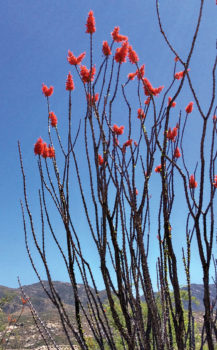
Ocotillo in full bloom
Louise Grabell
When I arrived in SaddleBrooke 12 years ago (wow—12 years already!) we were taken on a tour. Being an avid gardener from back east, I was enthralled with the desert landscape but I couldn’t quite understand why such a beautiful community would keep barren, apparently dead plants in the ground all around the roadways where you could see them. The branches (or stems) were very tall, covered with ugly thorns and they had no seemingly intrinsic value. What was wrong with the HOA? How could they overlook this much-needed removal problem?
Stupid easterner! That was me, and that was then. Now I am awed by the glory that is the Ocotillo (Fouquieria splendens). What a triumph of nature. And such a good idea to grow leaves and flowers when it rains in the desert and discard them when it’s too dry to maintain them without water. Damned Mother Nature, she thinks of everything!
So, wanna grow an Ocotillo? You may have good luck rooting one of the canes from an adult plant. Most often Ocotillo are sold bare-root and you will need to dig a hole deep enough to cover all the roots while stabilizing the branches until new roots grow to support the plant. Make sure you’ve dug in a sunny location and use three stakes and some cord to stabilize a new Ocotillo planting. You should leave the stakes around the plant for three to four years. Slow grower – eh? Not to worry as the stakes and the Ocotillo canes will look the same! And don’t forget to untie your Ocotillo canes after you’ve got it properly planted. While you don’t want to keep the roots wet all the time, do provide irrigation every 10 days in summer and monthly in winter for at least 2-3 years until the Ocotillo is happy where you planted it. In fact, don’t be surprised if the darned plant looks dead for two years! You can test its vitality by bending back one of the spines to see if the cane is green underneath.
The red Ocotillo flowers are outstanding—and the birds think so too. The tubular blossoms are hummingbird magnets. I have observed sparrows, orioles, cactus wrens, cardinals, finches and others happily munching on the flowers of a blooming Ocotillo. We see this awesome display of gorgeous crimson flower clusters (reminiscent of lilac blossoms) anytime in the spring, summer or fall depending on the rainfall. Even without leaves, flowers may appear and photosynthesis occurs in the barren green portions of the canes.
The Master Gardeners of SaddleBrooke invite you to visit their website: sbmastergardeners.wordpress.com for all up-to-date information and events for our community. Garden questions? You can reach our very own SaddleBrooke Garden Helpline by calling Pat at 407-6459. Your phone call will be forwarded to a Master Gardener Volunteer who will aid you in solving your problem. Your SaddleBrooke Master Gardener Volunteers are here all year round to assist with any plant or landscaping problem.
Remember, nothing brings more tranquility to the heart than a beautiful garden.
